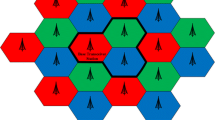Abstract
The performance of long term evolution-advance (LTE-A) depends on different factors such as spectral efficiency, throughput and signal interference to noise ratio (SINR). Interference causes the performance of a network to be grassed to very low level, it directly affects the parameters such as noise interference, receiving diversity and system receiving gain so to mitigate the interference in LTE-A network is very important. Interference occurs in two forms, intra-cell interference and inter-cell interference. Intra-cell interference is removed by orthogonal frequency division multiple access, but the problem of inter-cell interference still exists due to reception of signals from two adjacent base stations at same frequency on user equipment, so coordination is applied between the cells to reduce the interference between the cells. This paper focuses on coordination between the base stations using dynamic cooperative Base Station selection (DCBS). In this paper, SINR, system capacity, minimum and maximum rates of the system are analyzed when coordination is applied between the cells. Three different scenarios are discussed in this paper, which includes coordinated multipoint transmission and reception (COMP), non-COMP and DCBS and then the results of these scenarios are compared.




Similar content being viewed by others
References
Cox, C. (2012). An introduction to LTE: LTE, LTE-advanced, SAE and 4G mobile communications (1st ed., pp. 19–25). London: Wiley.
Tong, Z, Li, B., & Liu, M. (2011). A novel downlink coordination scheme for CoMP SU-MIMO. In Network computing and information security (NCIS) (pp. 121–125).
Madan, R., Borran, J., Sampath, A., Bhushan, N., Khandekar, A., & Ji, T. (2010). Cell association and interference coordination in heterogeneous LTE-A cellular networks. IEEE Journal on Selected Areas in Communications, 28, 1479–1489.
Shahid, A., Aslam, S., Sohaib, S., Kim, H. S., & Lee, K.-G. (2014). A self-organized metaheuristic approach towards inter-cell interference management for LTE-Advanced. EURASIP Journal on Wireless Communications and Networking, 24, 1–15.
Ma, J., & Baligh, M. (2015). System and method for self-optimized inter-cell interference coordination. U.S. Patent 9,031,591.
Tseng, H.-W., Lee, Y.-H., Lin, J.-Y., Lo, C.-Y., & Jan, Y.-G. (2012). Performance analysis with coordination among base stations for next generation communication system. Progress in Electromagnetics Research, 36, 53–67.
Network, T. S. G. R. A. (2009). Tr 36.814-further advancements for e-utra: Physical layer aspects (release 9). 3rd Generation partnership project technical report, technical report.
Seifi, S., & Nima, M. (2012). Base station coordination in multicell mimo networks (pp. 27–33). Gothenburg: Chalmers University of Technology.
Raheem, A., Rand, K., Lasebae, A., Aiash, M., & Loo, J. (2016). Performance evaluation of mobile users served by fixed and mobile femtocells in LTE networks. Journal of Networking Technology, 7(1), 17–23.
Bertrand, K., Deflandre, M., & Yu, C. Y. (2016). Base station coordination towards an effective inter-cell interference mitigation. International Journal of Future Generation Communication and Networking, 8(2), 45–58.
Osman, M., Hashim, T., Alsedig, M. A. A., & Bakheit, M. A. A. (2016). Performance evaluation of self-organizing relays in LTE. Ph.D. diss., Sudan University of Science and Technology.
Sonia, & Saini, G. S. (2017). Optimized RSS based algorithm for heterogeneous networks. Indian Journal of Science and Technology, 9(47). https://doi.org/10.17485/ijst/2016/v9i47/106427.
Chikte, C., Kartiki, K., & Rajesh, A. (2016). Performance analysis of an improved CSI feedback technique for LTE-A system with Femtocell Interference. In 2nd IEEE international conference on engineering and technology (ICETECH), Coimbatore, TN, India (pp. 1055–1058).
Seo, L., Jongpil, K., Kim, H., Ahn, J., & Chung, J. (2017). Macrocell protection interference alignment in two-tier downlink heterogeneous networks. Mobile Information Systems, 2017. Article ID 7410546,
Patel, H., Gandhi, S. D., & Vyas, D. (2016). A research on spectrum allocation using optimal power in downlink wireless system. International Research Journal of Engineering and Technology (IRJET), 03(04). https://www.irjet.net/archives/V3/i4/IRJET-V3I4501.pdf.
Ramachandran, V., & Nithyanandan, L. (2017). Dynamic cooperative base station selection scheme for downlink CoMP in LTE-advanced networks. Wireless Personal Communications, 92(2), 667–679.
Author information
Authors and Affiliations
Corresponding author
Rights and permissions
About this article
Cite this article
Ghori, M.U., Naeem, B. & Kakar, F.K. Comparative Analysis of Intercell Interference Mitigation Techniques in LTE-A Network. Wireless Pers Commun 99, 1159–1168 (2018). https://doi.org/10.1007/s11277-017-5170-7
Published:
Issue Date:
DOI: https://doi.org/10.1007/s11277-017-5170-7




